Transcriptome analysis of differentially expressed circRNAs miRNAs and mRNAs during the challenge of coccidiosis
- PMID: 36458003
- PMCID: PMC9706185
- DOI: 10.3389/fimmu.2022.910860
Transcriptome analysis of differentially expressed circRNAs miRNAs and mRNAs during the challenge of coccidiosis
Abstract
Avian coccidiosis is a common enzootic disease caused by infection of Eimeria species parasites. It causes huge economic losses in the global poultry industry. Current control using anticoccidial drugs or vaccination is limited due to drug resistance and the relatively high cost of vaccines. Improving host genetic resistance to Eimeria species is considered an effective strategy for improved control of coccidiosis. Circular RNAs (circRNAs) have been found to function as biomarkers or diagnoses of various kinds of diseases. The molecular biological functions of circRNAs, miRNAs, and mRNAs related to Sasso chicken have not yet been described during Eimeria species challenge. In this study, RNA-seq was used to profile the expression pattern of circRNAs, miRNAs, and mRNAs in spleens from Eimeria tenella-infected and non-infected commercial dual-purpose Sasso T445 breed chickens. Results showed a total of 40 differentially expressed circRNAs (DEcircRNAs), 31 differentially expressed miRNAs (DEmiRNAs), and 820 differentially expressed genes (DEmRNAs) between infected and non-infected chickens. Regulatory networks were constructed between differentially expressed circRNAs, miRNAs, and mRNAs to offer insights into the interaction mechanisms between chickens and Eimeria spp. Functional validation of a significantly differentially expressed circRNA, circMGAT5, revealed that circMGAT5 could sponge miR-132c-5p to promote the expression of the miR-132c-5p target gene monocyte to macrophage differentiation-associated (MMD) during the infection of E. tenella sporozoites or LPS stimulation. Pathologically, knockdown of circMGAT5 significantly upregulated the expression of macrophage surface markers and the macrophage activation marker, F4/80 and MHC-II, which indicated that circMGAT5 might inhibit the activation of macrophage. miR-132c-5p markedly facilitated the expression of F4/80 and MHC-II while circMGAT5 could attenuate the increase of F4/80 and MHC-II induced by miR-132c-5p, indicating that circMGAT5 exhibited function through the circMGAT5-miR-132c-5p-MMD axis. Together, our results indicate that circRNAs exhibit their resistance or susceptive roles during E. tenella infection. Among these, circMGAT5 may inhibit the activation of macrophages through the circMGAT5-miR-132c-5p-MMD axis to participate in the immune response induced by Eimeria infection.
Keywords: MMD; avian coccidiosis; circMGAT5; circRNAs; sasso chicken.
Copyright © 2022 Chen, Wang, Chen, Akinci, Luo, Xu, Jebessa, Blake, Sparks, Hanotte and Nie.
Conflict of interest statement
The authors declare that the research was conducted in the absence of any commercial or financial relationships that could be construed as a potential conflict of interest.
Figures

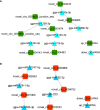
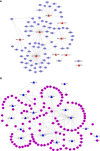
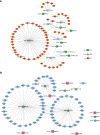
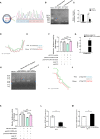
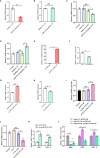
Similar articles
-
Genome-wide analysis of differentially expressed profiles of mRNAs, lncRNAs and circRNAs in chickens during Eimeria necatrix infection.Parasit Vectors. 2020 Apr 3;13(1):167. doi: 10.1186/s13071-020-04047-9. Parasit Vectors. 2020. PMID: 32245514 Free PMC article.
-
Transcriptome analysis reveals that gga-miR-2954 inhibits the inflammatory response against Eimeria tenella infection.Int J Biol Macromol. 2024 Jun;269(Pt 1):131807. doi: 10.1016/j.ijbiomac.2024.131807. Epub 2024 Apr 25. Int J Biol Macromol. 2024. PMID: 38670189
-
Comprehensive Analyses of circRNA Expression Profiles and Function Prediction in Chicken Cecums After Eimeria tenella Infection.Front Cell Infect Microbiol. 2021 Mar 10;11:628667. doi: 10.3389/fcimb.2021.628667. eCollection 2021. Front Cell Infect Microbiol. 2021. PMID: 33777841 Free PMC article.
-
RNA-Seq Revealed a Circular RNA-microRNA-mRNA Regulatory Network in Hantaan Virus Infection.Front Cell Infect Microbiol. 2020 Mar 13;10:97. doi: 10.3389/fcimb.2020.00097. eCollection 2020. Front Cell Infect Microbiol. 2020. PMID: 32232013 Free PMC article. Review.
-
Transgenic Eimeria parasite: A potential control strategy for chicken coccidiosis.Acta Trop. 2020 May;205:105417. doi: 10.1016/j.actatropica.2020.105417. Epub 2020 Feb 24. Acta Trop. 2020. PMID: 32105666 Review.
Cited by
-
Invasion mechanisms of Eimeria coccidian and host immune responses in chicken intestine_A review.Poult Sci. 2025 Jul 17;104(10):105560. doi: 10.1016/j.psj.2025.105560. Online ahead of print. Poult Sci. 2025. PMID: 40752203 Free PMC article. Review.
-
CircDCLRE1C Regulated Lipopolysaccharide-Induced Inflammatory Response and Apoptosis by Regulating miR-214b-3p/STAT3 Pathway in Macrophages.Int J Mol Sci. 2022 Jun 19;23(12):6822. doi: 10.3390/ijms23126822. Int J Mol Sci. 2022. PMID: 35743265 Free PMC article.
-
Genome-wide analysis of circular RNA-mediated ceRNA regulation in porcine skeletal muscle development.BMC Genomics. 2023 Apr 12;24(1):196. doi: 10.1186/s12864-023-09284-7. BMC Genomics. 2023. PMID: 37046223 Free PMC article.
-
Emerging roles of circular RNAs on the regulation of production traits in chicken.Poult Sci. 2025 Jan;104(1):104612. doi: 10.1016/j.psj.2024.104612. Epub 2024 Nov 28. Poult Sci. 2025. PMID: 39647355 Free PMC article. Review.
-
MicroRNA expression profile of chicken jejunum in different time points Eimeria maxima infection.Front Immunol. 2024 Jan 15;14:1331532. doi: 10.3389/fimmu.2023.1331532. eCollection 2023. Front Immunol. 2024. PMID: 38288128 Free PMC article.
References
Publication types
MeSH terms
Substances
LinkOut - more resources
Full Text Sources
Research Materials
Miscellaneous

